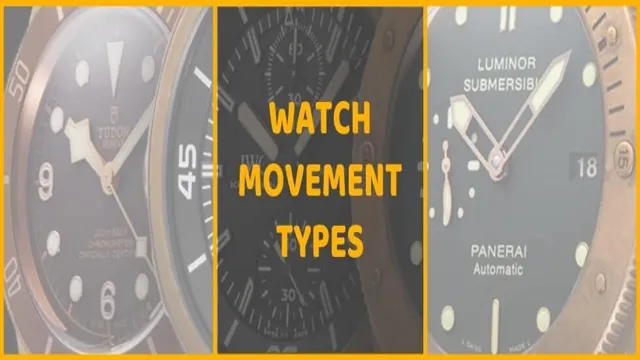Have you ever found yourself curious about the different mechanisms that power wristwatches? The intricate world of watch movements may seem overwhelming at first, but understanding the types of watch movements can greatly enhance your appreciation of timepieces. From the traditional mechanical movements to the modern quartz movements, each type has its unique features that cater to different lifestyles and preferences. Think of watch movements as the heart of a watch – they keep the time ticking and the watch running.
In this article, we delve into the different types of watch movements and what sets them apart. So sit back, relax, and let’s explore the world of watch movements.
Mechanical Movements
Watch movements can be categorized into three types: mechanical, quartz, and automatic. Mechanical movements are the oldest and most traditional type, dating back to the 16th century. These movements are powered by a spring that is manually wound up by the wearer.
The spring sends energy through a series of gears to power the movement of the watch hands. Mechanical movements are recognizable by their characteristic ticking sound, which comes from the movement of the gears within the watch. Many watch enthusiasts appreciate the craftsmanship and artistry that goes into creating a mechanical movement, as well as the connection it provides to watchmaking history.
However, these movements require regular servicing to maintain accuracy, and they can be sensitive to factors such as temperature and magnetism. Overall, mechanical movements offer a unique blend of tradition, craftsmanship, and performance for those who appreciate the intricacies of watchmaking.
Manual Wind
The term “manual wind” refers to a type of mechanical movement found in watches. Instead of relying on a battery or electronic component to power the watch, a manual wind movement requires the wearer to physically wind the watch by turning the crown. This process stores energy in a mainspring that powers the watch until it needs to be wound again.
Some watch enthusiasts prefer manual wind movements because of their traditional appeal and the hands-on approach to keeping the watch running. Additionally, manual wind watches generally have longer power reserves than their automatic counterparts, so they can run for several days without needing to be wound again. Overall, manual wind movements offer a nostalgic charm and a connection to the history of watchmaking as well as a strong reliability aspect of being able to easily ensure that the watch is always powered.

Automatic
Automatic mechanical movements are an excellent example of how innovation can bring convenience and ease to our daily lives. These movements are designed to self-wind through the simple movement of the wearer’s wrist. Unlike manual movements, automatic movements do not require periodic winding or an external power source.
The beauty of this system is that it is self-sustaining. Once set, the watch movement continues to regulate itself without requiring any further intervention from the wearer. Automatic movements are perfect for those who don’t have the time or patience for regular maintenance and winding of their timepieces.
They are reliable, convenient, and offer an effortless way to keep your watch ticking. The best part is that automatic movements are not limited to a particular type or style of watch. From dress watches to sports watches, automatic mechanical movements are available in numerous options.
So, whether you prefer a classic or modern look, there’s an automatic watch for you.
Mechanical Chronograph
Mechanical Chronograph Mechanical chronographs are a type of watch movement that has gained popularity due to their accuracy and precision. These movements are powered by a series of gears which are meticulously crafted and assembled to release power. The main advantage of mechanical chronographs is that they offer a certain charm and romance that digital watches cannot replicate.
Mechanical movements require frequent winding, which adds to the ritual and excitement of owning a watch. The mechanism of mechanical chronographs is awe-inspiring, with the intricate interplay of parts and cogs. Each component has a specific function, and the perfect synchronization of these parts results in a smooth and reliable timepiece.
Owning a mechanical chronograph is like owning a piece of art, one that represents a bygone era of watchmaking. Its uniqueness and rarity make it a treasured possession, an heirloom to be passed down from generation to generation. In conclusion, mechanical chronographs are a masterpiece of engineering, their intricate details making them an extraordinary piece of art.
Quartz Movements
If you’re in the market for a new watch, it’s important to understand the different types of watch movements available. One common type is the quartz movement. This type of movement is powered by a battery and relies on a crystal oscillator to keep accurate time.
The crystal oscillator vibrates at a precise frequency, which is then measured and converted into the movement of the watch’s hands. Quartz movements are known for their accuracy and affordability, making them a popular choice for everyday wear. The battery typically lasts for several years before needing to be replaced, and quartz watches rarely require maintenance beyond that.
So if you’re looking for a reliable and low-maintenance timepiece, a watch with a quartz movement might be the perfect option for you.
Analog Display
Analog Display Analog display has been around for a long time, and it remains a beloved way to read time for many people. A quartz movement is what powers most analog watches today, and it is a highly accurate and reliable way to keep time. The quartz movements in analog watches work by using a battery-powered oscillator to vibrate a small piece of quartz crystal.
The frequency of the vibrations is then translated into an analog display of the time on the watch face. While quartz movements are highly accurate, they do require periodic battery replacements or rechargeable options. Analog watches are often appreciated because of their classic look and feel, and they can be found in a wide variety of styles, from dressy to sporty, making them a great option for any occasion.
So, if you enjoy the timeless elegance of an analog display and a high level of accuracy, consider investing in a quartz movement analog watch.
Digital Display
Digital display has become ubiquitous in our daily lives, from our smartphones to our home appliances. The technology behind digital displays has advanced rapidly, with quartz movements being a significant contributor to its precision and accuracy. Quartz movements operate by utilizing the piezoelectric properties of quartz crystals, which produce a steady and measurable oscillation when subjected to an electric current.
Compared to traditional mechanical movements, quartz movements have a higher degree of accuracy and require less maintenance, making them essential in digital watches and other timekeeping devices. Additionally, as technology continues to progress, digital displays employing quartz movements are becoming increasingly energy-efficient, allowing for longer battery life and reduced power consumption. Overall, quartz movements are an essential component of the digital display technology we rely on every day.
Solar-Powered Movements
When it comes to watch movements, there are three main types: mechanical, quartz, and solar-powered. Mechanical movements use a spring to power the watch, which is wound by hand or through the motion of the wearer’s wrist. Quartz movements use a battery that sends an electrical current through a quartz crystal, resulting in precise timekeeping.
Solar-powered movements, on the other hand, use solar panels to convert sunlight into energy, which is stored in a rechargeable battery. These watches have become increasingly popular due to their eco-friendliness and convenience; they don’t require regular battery replacements or winding. Solar-powered watches work by absorbing sunlight through their solar panels, which can be located on the dial or strap of the watch.
This energy is then converted and stored in a battery, which powers the watch even in low-light conditions. Some models can even run for several months without being exposed to sunlight! So, if you’re looking for a sustainable and reliable timepiece, a solar-powered watch might just be the way to go.
Photovoltaic Cells
Photovoltaic cells or solar cells are the backbone of solar-powered movements across the globe. These cells convert sunlight into electrical energy, which can then power everything from small-scale electronics to large-scale homes and buildings. The technology behind photovoltaic cells has been evolving over the years, making solar energy more efficient and affordable.
In fact, solar energy is now one of the fastest-growing sources of renewable energy. When it comes to sustainability and reducing our carbon footprint, solar-powered movements are playing a critical role. With the help of photovoltaic cells, we can harness the power of the sun to move towards a cleaner and more sustainable future.
So if you haven’t jumped on the solar-powered bandwagon yet, it’s time to consider making the switch and join the ever-growing movement towards solar energy.
Battery Backup
Battery backup is an important consideration for anyone who relies on solar-powered movements. While solar power is a fantastic renewable energy source, it’s also dependent on sunlight. That means that during periods of limited sunlight, like cloudy or stormy days, your solar-powered movements may not work as well as they should.
That’s where battery backup comes in. By storing excess energy generated during sunny days in battery backups, you can ensure that your solar-powered movements continue to function even during periods of limited sunlight. It’s like having an emergency power source that kicks in when you need it the most.
Plus, by using battery backups, you’re maximizing your use of all the energy generated by your solar panels, which means you get more bang for your buck in the long run. So if you’re serious about solar-powered movements, be sure to invest in battery backup.
Conclusion
In conclusion, the world of watch movements is a complex and varied one. From the precision of quartz to the elegance of mechanical, each type of movement offers a unique experience. Whether you’re a watch enthusiast or a casual wearer, understanding the intricacies of these mechanisms can deepen your appreciation for the artistry and engineering that goes into every timepiece.
So, next time you reach for your watch, take a moment to appreciate the inner workings that keep you ticking along.”
FAQs
What is quartz movement?
Quartz movement is a type of watch movement that uses a battery-powered oscillator to regulate the time. The energy from the battery is sent through a quartz crystal, which vibrates at a high frequency of 32,768 times per second to keep the time accurate.
What is mechanical movement?
Mechanical movement is a type of watch movement that uses a complex system of gears, springs, and levers to keep time. The energy is derived from winding the watch manually or automatically. The movement requires more maintenance than quartz, but is a popular choice for luxury watches.
What is automatic movement?
Automatic movement is a type of mechanical movement that uses the motion of the wearer’s wrist to wind the watch. The oscillating weight inside the watch moves back and forth with the wearer’s arm movements, which winds the spring and keeps the watch running.
What is solar-powered movement?
Solar-powered movement is a type of watch movement that uses a solar cell to convert light energy into electrical energy to power the watch. The solar panel is typically located under the watch dial and can be charged through sunlight or artificial light sources. This type of movement is a popular choice for eco-friendly watches.


